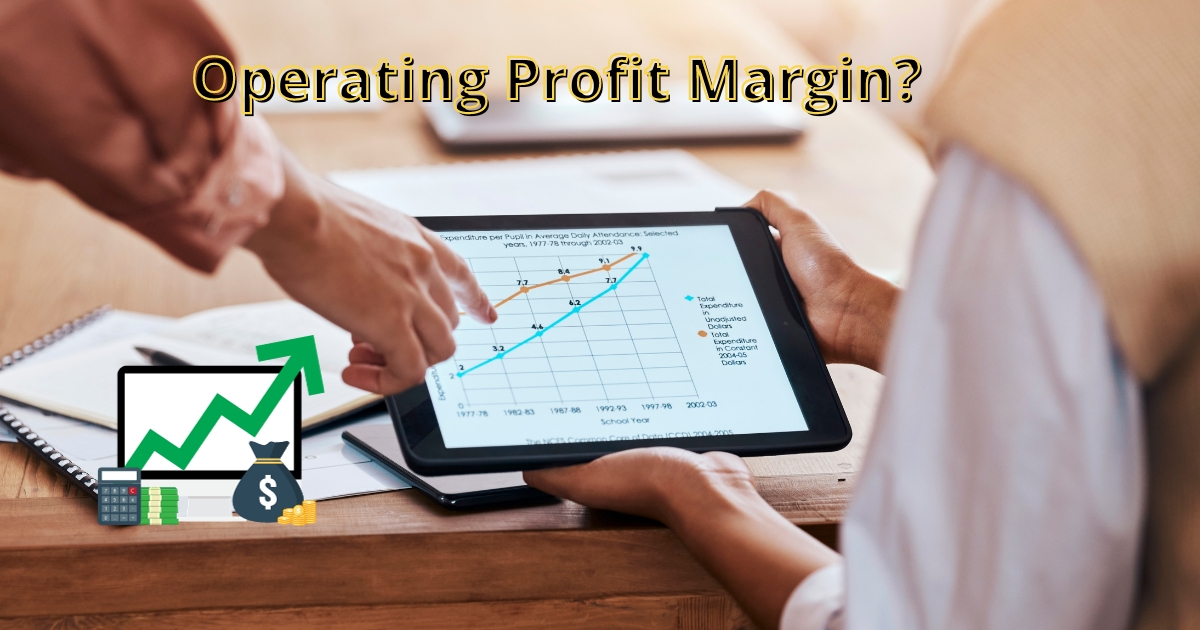Business owners need to keep a close watch on the operating profit margin. An operating margin formula calculates the accurate operating income or profit margin as a percentage of its ongoing net sales. It is the most significant value as it will be helpful for the investors to review. In addition, it simplifies and helps to compare the performance of other companies in the same industries or competitors. In this blog, let us learn more about what is operating margin, its formula and how it is calculated.
What is Operating Margin?
When calculating the operating profit margin, a company’s cost of goods sold and operating expenses are subtracted from the revenue produced during a particular period. The leftover revenue is the operating
margin of that particular accounting period. Operating margin is also known as return on sales(ROS).
It is calculated after deducting all the expenses such as wages and raw materials, variable costs for production etc. Operating margins are calculated by dividing the company’s operating income from the net sales. If the ratio of the operating margin is high, it is best for the company. It indicates that the company is efficient in its operations and proficient at turning sales into profits.
Furthermore, the operating profit margin reveals how well the company is managing its resources. It is one of the three profitability measures. Others are gross profit margin(profit minus the cost of goods sold) and net profit margin(difference between total sales and total costs and expenses, including interest and taxes and one-time items).
Investors and lenders pay close attention to it as it is required to pay a portion of non-operating expenses such as paying interest. Significant fluctuations in operating margins serve as a key signal of business risk. Similarly, analyzing a company’s historical operating margins provides valuable insights into the trajectory of its performance, indicating whether it has been improving over time.
The good thing is that operating margins can be improved with better management controls, careful management of resources, refined pricing, better strategic planning and effectual company decisions.
In simpler terms, the operating margin is the profit it achieves from its core business functions.
Operating Profit Margin Formula
Given below is the operating profit margin formula:
Operating Margin= Operating Earnings / Revenue * 100
In the operating margin calculation, the numerator represents a company’s earnings before interest and taxes (EBIT).
The operating margin is one of the metrics used by the financial team to analyse how much profit the company makes on each dollar of revenue and after-sales. After-sales revenue is calculated after accounting and paying for variable production costs such as raw materials and labour. However, the taxes or interests are paid later.
Expressed as a percentage, the operating margin is commonly interpreted as the portion of each sales dollar.
EBIT is determined as revenue less cost of goods sold (COGS) and the normal selling, general and administrative expenses excluding taxes or interests. Operating profit and total revenue consist of diverse line items. Total revenue includes Investment interest, income from sales and income from services. A company’s operating profit is the complete revenue after the deduction of these expenses. It includes the Cost of goods sold administrative costs, rent, payroll, utilities, other additional overhead costs, depreciation and amortization.
Taxes and loan interests are termed by the businesses as Earnings before Taxes and Interest, or EBIT as they are not factored into the operating profit calculation.
How to Calculate Operating Profit Margin?
Operating profit margin is most commonly known as operating margin. The operating margin is a percentage ratio that relates a company’s operating profit (EBIT) to its sales. A company can determine its operating income by subtracting operating expenses from its gross profit. The gross profit is already decreased by the cost of goods sold at that particular time.
In short, a company’s operating income is the leftover profit after deducting the expenses of the core business functions. The expenses are inclusive of COGS and OpEx. A company can calculate operating margin on a monthly, quarterly or yearly basis. If your company wants to do a comparative study accurate data is required. So, the operating margin is calculated depending on the requirements.
For example, assume a company with an operating profit (EBIT) of Rs 5,00,000 and sales totalling Rs 25,00,000. To calculate the operating profit margin, divide EBIT by sales and multiply by 100 to express it as a percentage.
a. Operating Profit Margin = (5,00,000 / 25,00,000) * 100
b. Operating Profit Margin = 20%
In this example, the company’s operating profit margin is 20%, indicating that 20% of its sales revenue translates into operating profit before interest and taxes. This metric reflects the efficiency of the company in managing its operating costs relative to its sales.
Operating Profit
The operating income is the amount of profit determined after subtracting operating costs (operating expenses such as salaries and raw materials), and the cost of goods sold(COGS)(rent, depreciation and amortization).
Selling, general and administrative expenses (SG&A) are the costs related to a company’s sales including general and administrative costs.
A manufacturer considers the cost of goods sold as the direct costs associated with producing goods such as the raw material cost, salaries of employees and freight charges.
The cost of sales also includes the direct cost of sales provided to the customers. This is a comparative metric in the service sector. Depreciation and amortization expenditures are also included in the core business activities. It also involves administrative and sales commissions.
Non-operating income and expenditures incurred from non-operational activities are not included in the operating income. Plus, one-time profits and losses are also not included.
Note that the operational income excludes investment income, one-time payments, sale of equipment gains, intangible asset impairment, and financial charges. In addition, income tax is also a vital deduction from operating income. Operating income aligns with earnings before interest and taxes (EBIT) when a business lacks non-operating operations. The subsequent formulas can be employed to ascertain operating income:
Operating Income = Net Sales Revenue – COGS – Operating Expenses
Operating Income = Net Income + Interest Expense + Taxes
Revenue
The total amount a company achieves after the sale of its goods and services is referred to as net sales. Further, the sum of all sales of a product or service is known as sales revenue. A company in its income statement discloses its gross or net sales revenue.
Revenue includes both sales and credit sales. It is based on the accounting method used in the organisation. Net sales revenue is derived by subtracting returns and any post-sale allowances and discounts, such as early-payment discounts, from gross sales. Net sales revenue is the starting point for calculating operating margin and operating income.
Operating Margin vs Gross Margin and Net Margin
The operational margin line item is distinguished by operating and non-operating line items on the income statement. While they represent different aspects, both operating margin and gross margin serve as indicators of a company’s efficiency in generating profits. In the income statement, the way these two represent the impact of costs and expenses are distinct.
In the operating margin of the financial statement, taxes and interest rates that represent the cost of funding a corporation are excluded. Consequently, it aids a business in evaluating its capacity to bear additional interest expenses, such as those linked to financing for expansion or capital expenditures.
Operating margin can be relevant when potential investors want to compare two businesses in the same industry with comparable business models.
The company exhibiting a higher operating margin tends to showcase greater efficiency. Gross margin, also referred to as gross profit margin, is a percentage that specifically considers expenses directly associated with the production and delivery of a company’s products or services.
Non-operating income and expenses are Earnings before interest and taxes (EBIT). It is also known as the items below the line.
Non-operating activities and exceptional profits or losses, such as interest from marketable securities, capital gains from asset sales, impairment of assets like inventory, and income taxes, may be encompassed within the non-operating segment.
Operating expenses and non-operating expenses are included in the net profit margin. Hence, the operating profit margin lies between the gross profit margin and the net profit margin.
Operating margin is not affected by any optional financial arrangements, accounting principles and tax structures, hence it will be more useful for peer comparisons.
Importance of Operating Margin
Operating margin is the best approach which reveals how a business gains its profits from its core business functions after the payment of fixed and variable expenses. All these profits can be reinvested in the company or can also be used for financial expansion. It represents the ratio of a company’s operational earnings to its revenues.
Operating Margin, here means that it will increase the value of the shareholders while at the same time providing current loans to the lenders.
If the ratio of the operating margin is lower, then the financial risk for the company is more. On the other hand, if the operating margin is higher, the financial risks are lower.
When the sales increase, the operating margin also increases and fixed costs are only a small part of costs. It is easy to determine if the operating margin is keeping up with the fluctuations in the profits.
Operating margin analysis can be leveraged by the companies to introspect their internal operations. In addition, it can also measure competitive profitability and can help with pricing.
→Industry Comparisons – A company can compare its operative effectiveness with other companies while omitting taxes(as it cannot be controllable).
→Efficiency analysis – Closely analysing the operating margin and its counterparts can be helpful for the business to eliminate costs wherever possible.
→Trend Analysis – Operating margin will be very helpful for the business by spotting patterns in profitability and has the capability to generate accurate estimates.
→Pricing Tactics – For determining pricing, operating margin will be an advantage for your business.
Limitations of Operating Margin
The operating margin approach can only be used to compare businesses of the same industries and with similar business models and annual sales. However, companies in different industries have distinct business models and operating margins, so comparing them is not valuable for the business.
Profit margin ratio is used by many analysts to compare the profitability between companies and industries. It avoids the impact of financial, accounting and tax policies – earnings before interest, taxes, depreciation, and amortization (EBITDA). For example, if the depreciation value is added, the reveue margins of large manufacturing companies and heavy industrial firms can be more comparable.
Sometimes EBITDA is utilized as a proxy for operating cash flow as it eliminates non-cash expenses like depreciation. Cash flow does not equal EBITDA. This is because it does not account for the rise in working capital or consider capital expenditure necessary to support production and sustain a company’s asset base, unlike operating cash flow.
Conclusion
Operating profit margin measures how efficiently a company generates income from its core operations. It reflects the percentage of each sales dollar left after covering variable costs like production and wages. A higher operating margin profit indicates strong profitability and efficient cost management, making it a valuable metric for investors and analysts. However, comparisons should be made within the same industry and considering trends over time for accurate assessment. ERP software will also be a helpful tool in analysing operating profit margins accurately.







